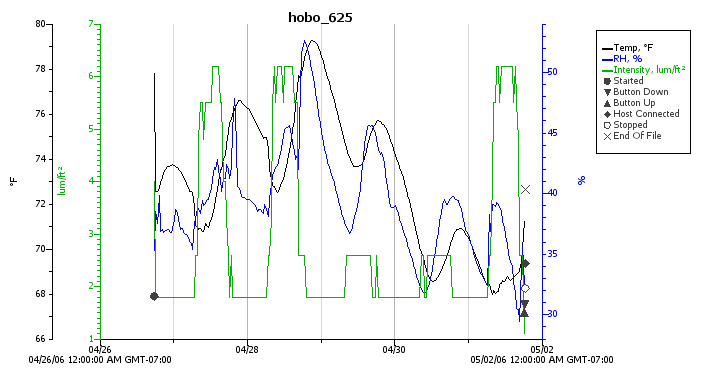Jefferson Middle School
Introduction
We monitored the energy usage patterns at Jefferson Middle School over a three week period, from April 24 to May 8, 2006. According to our analysis, energy usage did not accurately match occupancy and there were also discrepancies with comfort levels.
We used a monitoring device called a HOBO, which collected information about a room's temperature, relative humidity and light intensity. The data recorded from the HOBOs was compared with both a survey of occupants and with ASHRAE Standards (American Society of Heating, Refrigerating and Air-Conditioning Engineers, a national organization which sets codes and standards for buildings).
A HOBO produces a graph which looks like this:

The data collected by the HOBOs are very helpful in distinguishing both broad and specific problems in the system. However, the fact that the audit was performed in late spring caused those problems pertaining to heating to be unseen, because the building was not using much lighting and only minimal heating. A majority of the recommendations for saving electricity, and therefore money, were collected through a simple walk-through analysis of the building and pertain mostly to lighting.
Temperature
Interview
In an interview with Custodian Bruce Boren, the heat delivery system was described and presented to me along with lighting and each system's controls. According to Mr. Boren, the school is heated with hot water which is piped into each room. The rooms then have individual controls which power a fan. According to the temperature need in a room, the blower is turned on to blow in hot air, unheated air, or is turned off.
Surveys
The teachers who returned a survey were split in their comfort levels; however all but one teacher agreed that the school is too hot in the spring/fall and too cool in the winter months. Some teachers used alternative comfort needs, such as opening windows and using fans.
HOBO data
According to the data collected by the HOBOs and ASHRAE standards, the classrooms were getting too hot by the evening, and most classrooms were not within the thermal comfort zone during class time.
In the mornings many classrooms were below these standards. It is important to note that the standard range for thermal comfort is 67°F - 71°F, and every room exceeded 71°F at some point in the day, usually after 12:00pm. This effect was particularly profound in classrooms facing south.
To reduce the internal heat load of the building, we recommend passive cooling methods that use little money and no energy. Such methods include proper shading devices on windows which avoid conduction, as well as allowing all windows to be operable. In addition to this, there are windows available which are low-e, double-paned, argon filled windows which avoid heat transfer in and out a space.
Relative Humidity (RH)
Relative humidity is important in buildings because it is directly related to thermal comfort levels as well as proper ventilation. The average relative humidity of the rooms at Jefferson Middle School are within ASHRAE standards of 30-60% relative humidity. However, the 24-hour graphs reveal that the relative humidity of most rooms during class time is below ASHRAE standards, with humidity increasing in the evenings.
The explanation for these findings cannot be known for certain without a Professional Engineer (PE) but a possible cause is that the rooms are not properly ventilated. Ventilation is very important and the lack of it can cause poor air quality and deficient amount of moisture in the air.
Lighting
All of these recommendations did not come from the weekly monitoring using HOBOs, but rather from a formal audit of the building's energy use and an informal walk-through, which evaluated lighting and lighting design.
Our recommendations for lighting are to change the current fluorescent light bulbs from T-12 bulbs to T-8 bulbs and exchanging magnetic ballasts with newer, more energy efficient electronic ballasts. Installing these will result in immediate savings of energy.
At the time of retrofit, there could also be changes in the lighting design, like changing the placement and number of fixtures. In classrooms with expansive windows it is less important to have lights on near the windows during the day. We recommend installing multiple switches so lights close to windows can be turned off separately from the other lights.
Changing the system to automated controls with timers would also increase energy efficiency, but this and changes in lighting design require a lighting professional and exact estimates of savings are unknown.
Conclusion
In conclusion, the energy usage at Jefferson Middle School cannot be properly assessed due to the season and climate that the research was performed in. To get proper results, an audit could be performed again during the winter. However, by performing a walk-through of the building, there were simple changes that were revealed which can be made to save energy. A majority of these changes involve adjustments to the current lighting system and some recommendations for passive cooling which do not require energy.
